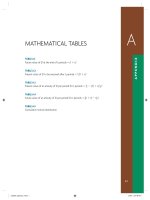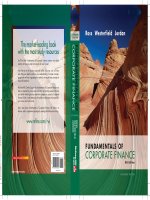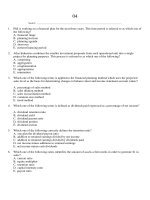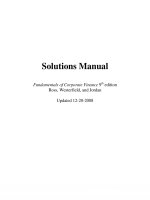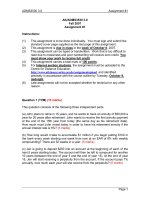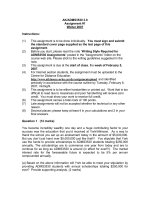exam solution 4 fundamentals of corporate finance, 4th edition brealey
Bạn đang xem bản rút gọn của tài liệu. Xem và tải ngay bản đầy đủ của tài liệu tại đây (45.5 KB, 11 trang )
3530 Midterm Exam – F2010 –Solutions
1. You are planning to establish a 20-year scholarship fund at York University that will
pay $25,000 at the end of the first year and then increase by 1.5% per year. The
manager expects that the fund will earn a 5.75% annual rate of return. How much should
you donate to York today in order to maintain this scholarship?
A) $50,346
B) $146,508
C) $278,225
D) $329,235
E) $588,235
Solution: D
This is a growing annuity.
T
C1 1 + g
PV of growing annuity =
1−
r − g 1 + r
20
25,0001 1 + .015
PV of growing annuity =
1−
.0575 − .015 1 + .0575
PV = 588,235.29 x (1 – 0.4403) = 329,235.29 (answers may vary slightly due to
rounding)
2. Compute the present value of the following set of payments for two years:
$300 each quarter for the first year and $600 each quarter for the second year. The
effective annual rate is 6% and payments will begin at the end of the first quarter.
A) $3,000.56
B) $3,340.77
C) $3,514.06
D) $3,854.02
E) $3,999.14
Solution B
The quarterly interest rate is (1+ .06)1/4 -1 = . 01467 =1.467%
Using your calculator:
PV Annuity 1:
PMT= 300; n=4, FV = 0; I/Y = 1.467, COMP PV
PV1 = $1,157.25
PV Annuity 2:
PMT= 600; n=4, FV = 0; I/Y = 1.467, COMP PV at start of year 2
PV = 2314.50 and bring back to time zero:
PV2 = 2314.50 / (1.01467)4 = 2,183.52
PV entire stream: = 1157.25 + 2183.52 = $3,340.77
3. How much will be in an account after 15 years if the initial deposit was $2500 and it
earned interest at an APR of 6%, compounded monthly?
A) $1,018.71
B) $1,242.42
C) $2,735.88
D) $5,030.49
E) $6,135.23
Solution E
im = APR/m = 6%/12 = .0050 or .50%
FV= 2500 x (1.005)^180 = $6,135.23
4. What is the effective annual rate on a deposit of $3,000 made eight years ago if the
deposit is worth $4,453.52 today? The deposit pays interest semi-annually.
A) 2.50%
B) 5.00%
C) 5.06%
D) 10.12%
E) 12.50%
Solution C
Using your calculator:
PV= -3,000
FV= 4,453.52
N=16
PMT =0
COMP I/Y
I/Y = 2.50% this is the semi-annual rate
EAR = (1+ .025)^2 -1 = 5.06%
5. You are planning to buy a new condominium in Toronto. The Condo is worth
$400,000; you will put a 10% down payment and obtain a 25-year fixed rate mortgage at
6.25% (APR semi-annually compounded) for the rest. You have decided to make weekly
payments which will begin at the end of the first week. What is your weekly payment?
(Assume there are 52 weeks in one year.)
A) $542.81
B) $608.42
C) $735.66
D) $808.21
E) $923.55
Solution: A
1. Find Semi-annual rate: is = 6.25% -> .0625/2 = .03125
2. Find EAR: EAR = (1.03125)2 – 1 = .06348
3. Find the weekly rate: iw = (1+ 0.06348)1/52 -1 = 0.001184
4. Find Number of payments in mortgage:
n = 25yrs x 52wks/yr = 1300 weeks
5. Find the monthly payment with a PV of $360,000 ($400,000 x 90% )
Using your calculator:
PV= -360,000, n=1300, i =0.1184%, FV=0, PMT=? Answer= $542.81
6. You believe that you will need $1,500,000 when you retire in 35 years from today.
You also know that you will receive an extra payment of $100,000 from your trust fund in
5 years time. How much will you need to save at the end of each of the next 35 years to
reach your retirement goal? You can earn 7% on your funds compounded annually
because you manage your own money and your undergraduate major was finance.
A) $3,667
B) $5,344
C) $10,127
D) $10,850
E) $12,643
Solution B
If you invest the $100,000 received in year 5 until your retirement in year 35, it will grow
to $100,000 × (1.07)30 = $761,225.50. Therefore, your savings plan would need to
generate a future value of only $1,500,000 – $761,225.50 = $738,774.50
Now, using your calculator:
FV= 738,774.50, n=35, I/Y = 7, PV=0, COMP PMT
PMT = $5,344,26
7. You have been so successful in your finance career that you can buy a second condo
today for $1.5 million. You think you can sell it in five years for $2 million. You will also
earn $120,000 per year in rent on the property in years 2 to 5 (only) and the rental
income occurs at the end of each year. If you want to earn at least a 10% annual return
on your investment, should you buy the condo?
A) Yes, the present value of all the cash inflows is greater than the purchase price.
B) Yes, the future value of the rental income is greater than the selling price.
C) No, the present value of all the cash inflows is less than the purchase price.
D) No, the future value of the rental income is less than the selling price.
E) You are indifferent as the cash inflows equal the cash outflows.
Solution A
First, find the PV of the rental payments (delayed annuity) and then add PV of selling
price.
Using your calculator: PMT = 120,000; n= 4; I/Y = 10%; FV = 0 ,
COMP PV PV ordinary annuity = 380,383.85
PV Delayed Annuity = 380,383.85 /(1.10) = 345,803.50
PV of selling price = 2,000,000/(1.10)5 = 1,241,842.65
Total PV = 345,803.50 + 1,241,842.65 = 1,587,646.15
Since Total PV cash inflows > Purchase price Yes, you should buy the condo.
8. You currently have $10,000 in the bank earning 0.50% per month. You need $35,000
to make a down payment on a house. You can save an additional $500 at the end of
each month. How long will it take for you to accumulate the $35,000?
A) Less than 1 year
B) Between 1 and 2 years
C) Between 2 and 3 years
D) Between 3 and 4 years
E) More than 4 years
Solution D:
Your savings goal is -35,000 = FV
You currently have $10,000 in the bank = PV
PMT = $500 and I/Y = 0.50%
Comp “n” = 41.06 months or between 3 and 4 years.
9. You are comparing a perpetuity having annual payments of $5,000, with a 20-year
annuity having the same payments. If interest rates are 7% annually and the payments
begin immediately, which of the following statements are true?
A) The present value of the perpetuity payments is $71,428
B) The present value of the annuity stream is $52,970
C) The perpetuity is worth over $19,000 more than the annuity stream
D) Both A) and B) are true
E) None of the above statements is true.
Solution C
The perpetuity due is worth $5000/.07 + $5,000 = $76,428.57
The PV of the twenty-year annuity due: Use your financial calculator and set the BGN
function: FV =0, PMT = 5,000; I/Y = 7%; n= 20, COMP PV
PV = $56,677.98
The difference between the perpetuity and annuity is $19,750.59
10. If the EAR is known to be 14.75% on a debt that has quarterly payments, what is the
APR on the debt?
A) 3.50%
B) 3.69%
C) 14.00%
D) 14.73%
E) 15.60%
Solution C
APR/m (or im) = (1 + EAR)1/m -1
The quarterly interest rate = (1.1475)1/4-1 = 3.50%
APR = im x m
So the APR = 0.0350 × 4 = 14.00%.
11. Joshua Inc. wants to sell bonds to finance its business expansion. To accomplish
this, they plan to sell 20-year, $6.2 million face value, zero-coupon bonds. The bonds will
be priced based on a yield to maturity of 9.5%. How many bonds must they sell to raise
the required capital?
A) 38,079
B) 42,500
C) 54,500
D) 57,500
E) 61,333
Solution: A
The bond price is the present value of all future cash flows discounted at the required
rate of return (i.e. YTM). Note that there are no coupons in this case.
Bond Price (PV) = $1,000 / (1 + 0.095)20 = $162.82 for 1 bond ($1,000 face value).
We have $6,200,000 (face value) bonds therefore the number of bonds required can be
calculated as $6,200,000 / $162.82 = 38,079
12. Julia Limited sells a 12-year semi-annual coupon bond that has an effective annual
return of 4.6529%. What is the amount of each interest payment if the bond issue price
is the same as the face value of the bond?
A)
B)
C)
D)
E)
22.50
22.75
23.00
46.00
45.53
Solution: C
First we need to calculate the YTM of the bond as an APR on the basis semi-annual
compounding.
YTM (APR) = m x [(1 + EAR)1/m – 1]= 2 x [(1 + 0.046529) ½ - 1] = 4.6% compounded
semi-annually.
Given that the bond is selling at face value. The annual coupon rate =YTM (4.6%).
Therefore the semi - annual coupon = ($1,000 x 4.6%)/ 2 = $23.
13. Ashley Inc. has a 20 year bond outstanding that is currently selling at a 4.5625%
premium with a 4.75% coupon rate. If the bond pays interest semi-annually what is the
yield to maturity?
A)
B)
C)
D)
E)
4.40%
4.45%
4.54%
4.61%
4.89%
Solution: A
PV
-1,045.625
FV
1000
N
2 X 20 =40
PMT 47.50/2 = 23.75
I
2.2022 per 6 mo. YTM = 2.2022 X2 = 4.40%
14. Kamal Ltd. has a 10 year bond outstanding that is quoted at a price of $1,002.19,
pays interest semi-annually and offers a yield to maturity of 5.97060%. What is the
coupon rate on this bond?
A)
B)
C)
D)
E)
3.00%
3.25%
6.00%
6.04%
6.50%
Solution: C
PV
-1,002.19
FV
1000
N
2 X 10 = 20
I
5.97060/2 = 2.98530% per 6 mo.
CPT PMT
30.00 X 2 = $60 p.a., which is 6.00%
15. A 15 year, 6% coupon bond pays interest annually. The bond has a face value of
$1,000. What is the change in the price of this bond if the yield to maturity rises from
6.25% to 6.5%?
A)
B)
C)
D)
E)
decreased by 2.37%
decreased by 2.43%
increased by 2.37%
decreased by 2.50%
increased by 2.43%
Solution: A
Initial bond price is the present value of all future cash flows discounted at the yield to
maturity.
Bond Price = PV of coupons + PV of the face value = $60 x PVIFA(6.25%, 15) + $1,000
/ (1 + 0.0625)15 = $573.33 + $402.78 = $976.11
If the yield to maturity increases to the 6.5% then the new bond price= $60 x
PVIFA(6.5%, 15) + $1,000 / (1 + 0.065)15 = $564.16 + $388.83 = $952.99
Based on the above the change in bond price = (Initial Bond Price – New Bond Price) /
Initial Bond Price = ($976.11 - $952.99) / $976.11 or that the bond price declined by
2.37%.
16.
What is the most likely value of the PVGO for a stock with current price of $50,
expected earnings of $6 per share, and a required return of 20 percent?
A)
B)
C)
D)
E)
$10
$20
$25
$30
$40
Solution B
Cash Cow Value = EPS / r = 6 / 0.2 = $30
PVGO = Price – Cash Cow Value = 50 – 30 = $20
17.
What is the expected, constant growth rate of dividends for a stock with a current price
of $100, expected dividend payment of $10 per share, and a required return of 16
percent?
A)
B)
C)
D)
E)
6.00 percent
6.25 percent
8.00 percent
10.00 percent
12.00 percent
Solution A
g = r – D1/P0
g = 0.16 – 1 / 100 = 0.06
18.
What is the value of the expected dividend per share for a stock that has a required
return of 16 percent, a price of $45, and a constant growth rate of 10 percent?
A)
B)
C)
D)
E)
$2.70
$3.60
$4.50
$7.20
$9.60
Solution A
D1 = P0 (r – g)
D1 = 45 (0.16 – 0.10) = $2.70
19.
What should be the stock value one year from today for a stock that currently sells for
$35, has a required return of 15 percent, an expected dividend of $2.80, and a constant
dividend growth rate of 7 percent?
A)
B)
C)
D)
E)
$37.45
$37.80
$40.25
$43.05
$45.03
Solution A
P1 = P0 (1 + g)
P1 = 35 (1 + .07) = $37.45
20.
ABC companies earnings and dividends are expected to grow at a rate of 10% in year
1, 10% in year 2, 8% in the third year, and at 6% thereafter. If current dividend paid was $2.00
and the required rate of return on its common stock is 12%. How much should you pay today for
one share of ABC?
A)
B)
C)
D)
E)
$19.31
$24.66
$38.62
$51.93
$59.13
Solution C
DIV0 = $2.00
DIV1 = $2.20
DIV2 = $2.42
DIV3 = $2.6136
DIV4 = $2.7704
P3 = DIV4 /(r-g) = 2.7704/.12-.06) = $46.1736
P0 = DIV1 / (1 + r) + DIV2 / (1+r )2 + DIV3 / (1 + r)3 + P3 / (1 + r)3
= 2.20 / (1.12) + 2.42 / (1.12)2 + 2.6136 / (1.12)3 + 47.1736 / (1.12)3 = $38.62
Conceptual Questions (2 marks each)
21. Which of the following statements is/are accurate with respect to time value of
money? All else being the same.
I. present values increase as the discount rate increases
II. present values increase as the future value is further away in terms of time
III. present values are always smaller than future values when both “r” and “t” are
positive.
A)
B)
C)
D)
E)
I only
I and II only
II only
III only
II and III only
Solution: D
22. Monika has $6,000 in her investment account. She wants to withdraw her funds
when her account reaches $10,000. A decrease in the rate of return on her investment
over this period will:
A)
B)
C)
D)
E)
Increase the value of her account faster.
Cause her to wait longer before withdrawing her money.
Cause the present value of her account to decrease.
Allow her to withdraw more money sooner.
Cause the compounding effect to increase.
Solution: B
23. Suppose you are evaluating two annuities. They are identical in every way, except
that one is an ordinary annuity and one is an annuity due. Assuming an interest rate of
10% per annum, which of the following is true?
A)
B)
C)
D)
E)
The ordinary annuity must have a higher present value than the annuity due.
The annuity due must have the same present value as the ordinary annuity.
The ordinary annuity must have a lower future value than the annuity due.
The present value of annuities will differ by the one annuity payment.
Answers C & D are correct.
Solution: C
24. Ashley has a credit card that charges interest every month to her account balance.
In this case, Ashley is paying an effective annual interest rate that:
A)
B)
C)
D)
E)
Equals the rate stated on her billing statement as the APR.
Is equal to the APR compounded continuously.
Is greater than the APR shown on her billing statement.
Is equal to the annual percentage rate as required by the government.
Will decline automatically as her account balance declines.
Solution: C
25. Johan wants to save $1,200 a year. In order to maximize his future savings, he
should:
A)
B)
C)
D)
E)
Deposit $1,200 into his savings account on the last day of each year.
Deposit $100 each month as an annuity due.
Deposit $100 each month as an ordinary annuity.
Deposit $300 into his account at the end of each quarter.
Deposit $600 into his account at the end of every six month period.
Solution: B
26. Coop Products, Inc. just issued 10-year, 8% coupon bonds at par. Outstanding
Elkana Corp. bonds, which have a maturity of 10 years, sell at a premium and are
viewed by investors as having the same risk as the Coop bonds. Therefore, it must be
true that the:
A)
B)
C)
D)
E)
Coupon rate on the Elkana bonds is equal to that on the Coop bonds.
Coupon rate on the Elkana bonds is higher than that on the Coop bonds.
Coupon payment on the Elkana bonds is lower than that on the Coop bonds.
Yield to maturity on the Elkana bonds is higher than the YTM on Coop bonds.
Elkana bonds pay coupons more often than twice a year.
Solution: B
27. Jimmy wants to compute the present value of a six year semi-annual 8% coupon
bond that has a 9% yield to maturity. Which one of the following is correct?
A)
B)
C)
D)
E)
The number of interest payments is twelve.
The present value is assumed to be $1,000.
The amount of each interest payment is $80.
The bond is selling at a premium.
Both A & C are correct.
Solution: A
28.
Which of the following is least assured for firms that plowback a portion of earnings
into the firm?
A) Growth in earnings per share.
B)
C)
D)
E)
Growth in dividends per share.
Growth in book value of equity.
Growth in stock price.
Growth in return on equity
Solution D
29.
To justify a high P/E ratio, the market must believe one of the following about a firm:
A) It has low growth opportunities.
B) It will have constant dividends forever.
C) It has high growth opportunities.
D) It will use low depreciation to increase earnings.
E) It will increase dividends gradually
Solution C
30. A corporation’s board of directors:
A) is selected by and can be removed by management.
B) can be voted out of power by the shareholders.
C) has a lifetime appointment to the board.
D) is also elected by customers of the corporation
E) is responsible for the day-to-day operations of the corporation
Solution B

